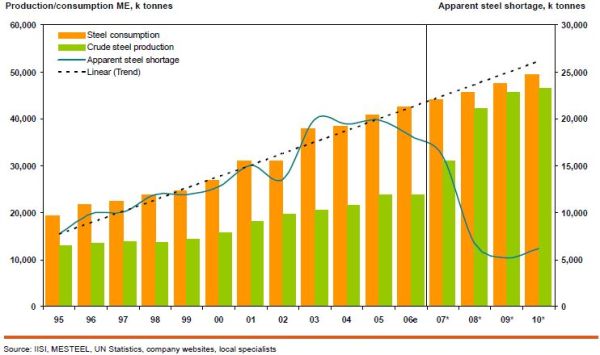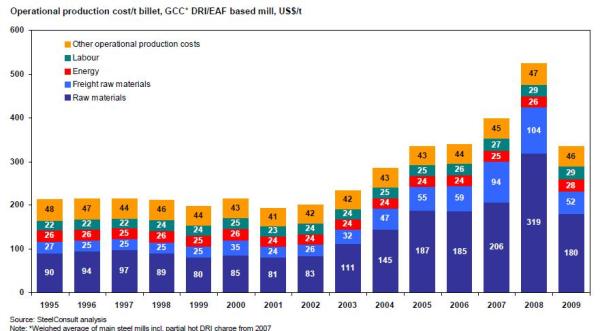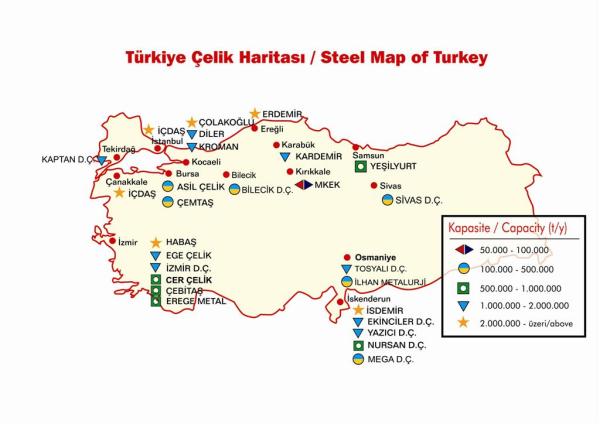Outlook for the Middle East out to 2015
2014 has not been without its challenges, and 2015 will
also be another difficult year. However, on average MBR
believes that rebar prices on average will only be 3-5%
lower compared to 2014 on a GCC cif basis. Despite
these challenges to steelmaker margins in the Middle
East, our outlook remains bright for the region. We
present our arguments to validate this view below.
The region in 2014 remained one of the fastestgrowing
in terms of steel production and
consumption, second only to Asia. GCC finished
steel consumption rose by 6.0% in 2014 and is
forecast to further grow by 6.1% in 2015.
Government federal budgets are largely set now.
Although based on nominal oil prices, it is our
view that the vast majority of the governments in
the region are still committed to large long-term
infrastructure and social investment – in part for
political reasons to avoid another Arab Spring.
Many of the Gulf economies have recorded large
budget surpluses for the past three years. They
would be willing therefore to run short-term
deficits in order to continue these investments.
Regional DRI-EAF producers are still extremely lowcost
thanks to low-priced natural gas, which is priced
well below international levels. Moreover, these are
often fixed under long-term contracts providing
substantial advantages over the longer-term. Other
subsidies include long-term power contracts or
discounted power access or access to state-backed
financing. There are also buy-local schemes in GCC
markets such as Kuwait that provide financing based
on buying locally-sourced steel.
The recent complaints about China may fade
in 2015 as less Chinese material arrives into
the Middle East. There are two parts to this
hypothesis:
First we factor in that China has amended its
export tax rebate in January 2015. The removal
of the VAT rebate on alloy long product exports
will add around $40/tonne or so to Chinese
export costs.
Secondly, in our opinion, it has been relative
cost advantages that have fuelled a large part
of Chinese export volumes we have seen in
2014. We expect this dynamic to change from
2015.
This view is more convincing and powerful if we
take the running assumption that the Chinese
government will act to further stimulate steel
demand growth next year. There are three key
reasons why:
i) Falling oil prices and metals prices in China will
naturally give a positive boost to manufacturing
and stimulate internal-led GDP growth.
ii) Rising deflation makes borrowing more
expensive and for those Chinese firms who are
indebted makes it harder for them to service
their debts
iii) Rising deflation presents new room for the
Chinese government to go beyond the recent
surprise changes to interest rates and provide
further growth monetary stimulus to the
economy.
Given that China is therefore moving into a deflationary
period this means that to regain credibility and policy
effectiveness the Chinese government will need to ease
monetary policy much more, probably in the form of
lowering the reserve requirement ratios among China’s
banks at least throughout the first half of 2015. This
would be a positive move to mitigate Chinese steel
exports to global markets for 2015.
In conclusion and in our opinion, 2015 will mark the
low-point for global steel products for several years,
however, steel prices are not expected to dramatically
fall for the reasons outlined above. Fundamentally,
there will be a recovery through 2016 – albeit with
continued cyclicality and with Chinese mills capping
any major price increase with rising exports.
Why steelmaker attempts at further trade
protectionism in 2015 will utimately fail
Steelmakers in the Middle East are clamouring to seek
out legal advice as to how they can copy Egypt (in the
case of Turkish rebars) and others and look to protect
their markets from imports beyond the current 5%
import duty.
Irrespective, in many circumstances, we do not
believe that governments will provide additional
protection steelmakers may look to seek. There will
be little rest bite among regional steelmaker margins
in 2015. We list some key reasons below:
In many countries, it is the state that drives
much of the infrastructure expenditure
on which steel consumption is based.
Cheap housing for a growing young Arab
population is a key priority for many
governments. By protecting the domestic
steel industry, it would therefore ensure
that it pays a higher price for its capital
investment.
It also passes the cost down to further steel
processing or manufacturing industries.
These then pay a higher price and are then
even less able to be competitive with imports.
With many regional governments seeking
to diversify their economies and encourage
manufacturing, we find it hard to believe that
they will act to widely damage manufacturing
industry by protecting the steel industry.
According to a recent report, the Arab world
needs as many as 17m new jobs by 2020
based on demographic calculations.
Finally, many countries either do not have
the right legal infrastructure/frameworks
to best deal with such complicated trade
issues, or the decision-makers at the
very top would have their own business
interests affected by higher steel costs. So
regional steelmakers can prepare all the
documentation and reports they want to try
and prove a convincing case for hiking up
import tariffs, but this will continue to find a
lack of support or drive at many of the key
levels of government.






